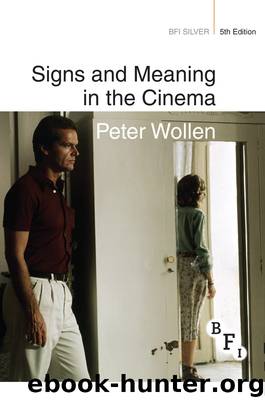Signs and Meaning in the Cinema by Wollen Peter

Author:Wollen, Peter.
Language: eng
Format: epub
Publisher: Palgrave Macmillan Ltd.
The Writings of Lee Russell: New Left Review (1964–7)
Samuel Fuller
[First published in NLR no. 23, January/February 1964, pp. 86–9]
Samuel Fuller was one year old when Walsh made his first film, three years old when Chaplin made his first, four years old when Griffith made Birth of a Nation, six years old when Ford made his first. Many veterans of the silent film are still alive, working or looking for work: Swan, Lang, Hitchcock, Hawks, Renoir, Vidor. Fuller made his first film, I Shot Jesse James, after two decades of sound, in 1949. He is a post-Welles director, a little older than Welles, whose films appear along with films made by directors whose cinema careers began before Welles was born. The fantastically foreshortened time-scale of the cinema has meant that few American directors are seen in their proper perspective, Fuller perhaps least of all. Even an informed critic like Andrew Sarris, writing in Film Culture, has described Fuller as a ‘primitive’; his failure to treat ‘contemporary’, ‘real-life’ subjects and situations has led most critics to lose sight of his distinctiveness and to relegate him into the ranks of the ‘action directors’ who are thought of as making up the solid, traditional rearguard of American cinema rather than its brilliant, exceptional vanguard. Ritt, Cassavetes and Sanders excite critical attention, while Fuller is neglected.
Fuller has worked consistently within the American cinema genres: Western, gangster, Pacific war. These genres, I would argue, are the great strength of the American cinema. America is a comparatively young nation which has grown very rapidly into a leading global power. It is no accident that the epochs of the cinema genres are also the epochs of crisis in America’s consciousness of itself, its national identity and its role in history. The American cinema helped to develop the national consciousness while it developed its own genres, through its mutually responsive relationship with its mass public. American cinema has developed artistically out of the romantic movement and of national consciousness. This trend was strengthened by the emergence of the genres, in which themes and attitudes could be systematically developed. The work of Fuller in these genres represents a far point of bourgeois romantic—nationalist consciousness, in which its contradictions are clearly exposed.
Fuller’s world is a violent world, a world of conflict: Red Indian v. white man, gangster v. police, American v. Communist. (Fuller has updated the Pacific war movie to deal with both Korea and Vietnam.) But neither the fronts nor the occasions for conflict are clearly delimited. Battles take place in utter confusion: in thick fog, in snowstorms, in mazes. All Fuller’s war films are about encounters behind the enemy lines. Nor do the protagonists even know why or for what they are fighting. ‘How do you tell a North Korean from a South Korean?’ asks a puzzled GI in Steel Helmet. His stogie-chewing sergeant replies: ‘If he’s running with you, he’s a South Korean. If he’s running after you he’s a North Korean.’ In China Gate we see the
Download
This site does not store any files on its server. We only index and link to content provided by other sites. Please contact the content providers to delete copyright contents if any and email us, we'll remove relevant links or contents immediately.
The Kite Runner by Khaled Hosseini(4435)
Gerald's Game by Stephen King(3918)
The Perils of Being Moderately Famous by Soha Ali Khan(3782)
Dialogue by Robert McKee(3582)
Story: Substance, Structure, Style and the Principles of Screenwriting by Robert McKee(2985)
The 101 Dalmatians by Dodie Smith(2936)
The Pixar Touch by David A. Price(2739)
Confessions of a Video Vixen by Karrine Steffans(2674)
Fantastic Beasts: The Crimes of Grindelwald by J. K. Rowling(2543)
How Music Works by David Byrne(2525)
Harry Potter 4 - Harry Potter and The Goblet of Fire by J.K.Rowling(2416)
Slugfest by Reed Tucker(2415)
The Mental Game of Writing: How to Overcome Obstacles, Stay Creative and Productive, and Free Your Mind for Success by James Scott Bell(2393)
Wildflower by Drew Barrymore(2118)
Scandals of Classic Hollywood: Sex, Deviance, and Drama from the Golden Age of American Cinema by Anne Helen Petersen(2109)
Casting Might-Have-Beens: A Film by Film Directory of Actors Considered for Roles Given to Others by Mell Eila(2071)
Screenplay: The Foundations of Screenwriting by Syd Field(2057)
Robin by Dave Itzkoff(2005)
The Complete H. P. Lovecraft Reader by H.P. Lovecraft(1977)
